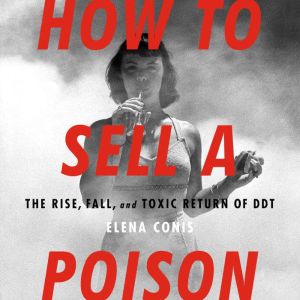Quotes
“The phrase ‘trust the science’ should be replaced with ‘understand how the science gets made.’ This deeply researched, beautifully written, and well-argued explanation of how DDT was sold, misregulated, and resold should scare everyone from the ardent scientist to the fearful conspiracy theorist into rethinking.”—Susan M. Reverby, author of Examining Tuskegee
“What Merchants of Doubt did for earlier campaigns of corporate disinformation, How to Sell a Poison does, superbly, for a toxin I thought we’d gotten rid of. Elena Conis’s fast-paced account is all the more important in an era when powerful forces are trying to discredit science.”—Adam Hochschild, author of King Leopold's Ghost
“Elena Conis is a historian who writes nonfiction like a fiction writer. In elegant prose, she reveals the often forgotten and captivating history of how ordinary people discovered the dangers of DDT—and persisted in having it banned against all odds and despite false assurances of its safety from public health officials.”—Sheldon Krimsky, author of GMOs Decoded
"Why do we still talk about DDT? In this provocative and richly detailed retelling of the DDT story, Elena Conis deftly explores why a pesticide banned since 1972 remains so politically divisive. For Conis, the answer lies in the intersection of science and politics, revealing a story rooted in the past, but framed by contemporary political and ecological debates. It is a fascinating story that will resonate with readers trying to make sense of the uncertainty of scientific knowledge in our highly politicized world.” —David Kinkela, author of DDT and the American Century
"Science is often thought to be the antonym of politics. Yet the human side of innovation, along with fierce competition, can create the conditions for behavior that is anything but apolitical. How to Sell a Poison brilliantly retells the story of the rise, fall, and reemergence of DDT to highlight how context shapes what we think we know about science and health policy. Rigorously researched and delightfully written, this book sets a new standard for science journalism."—Osagie Obasogie, author of Blinded by Sight
“In How to Sell a Poison, Elena Conis skillfully narrates the complex, toxic history of DDT, among the world’s most popular and dangerous chemical pesticides. Initially heralded, ultimately banned, still widely used, the vagaries of the production, sale, and regulation of DDT opens up the most fundamental questions of corporate greed, the role of government, and scientific practice. Anyone interested in the problem of scientific authority in our toxic world should read this important, essential book."—Allan M. Brandt, author of The Cigarette Century
"Elena Conis has rendered a frightening and thoroughly researched account of the poisoning of our environment and ourselves. With great precision and keen analysis, she plainly lays out the case for how one of the twentieth century’s most large-scale toxic exposure events was the direct result of corporate greed and manufactured doubt of science. The story always has been urgent, but no more so than now.”
—Samuel Kelton Roberts, Jr., author of Infectious Fear



